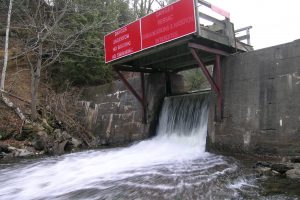History of Bolingbroke Dam on Bobs Lake:
The Bolingbroke Dam is owned and operated by Parks Canada. The dam was initially constructed in 1821 to power mills at the Hamlet of Bolingbroke. In 1870, the federal government bought the site to enhance the size of the reservoir for the Northern sector of the Rideau Canal. Bobs and Crow lakes are some of the largest feeder lakes to the Rideau Canal, which is a World Heritage site.
In 1871 the dam was significantly increased in size and the volume of water in Bobs Lake was raised considerably. The current dam has been in place since 1930 and has seen several major repairs over the course of its operation. The water levels of the Tay Watershed (incl. Bobs and Crow Lakes), is managed by Parks Canada through the Bolingbroke dam.
Parks Canada Dam Update (Nov 14, 2018)
As of November 14, 2019, construction work on Phase 1 of the new dam is scheduled to continue until February 2019. At that point, approximately two-thirds of the new dam structure will be completed.
The final phase of construction will begin around July 2019 and is expected to be completed in the Fall of 2019. At this point contruction into 2020 is not anticipated.
The contractors are now grouting the bedrock foundation of the dam in preparation to begin building the new dam structure on top.
The pouring of the concrete footings for the dam structure will begin in mid-November 2019.
By late February 2019, the contractor will take a brief break from in-water work in order to abide by the no construction restrictions.
These restrictions were put in place in order to protect fish populations during the 2019 spring spawning season.
Once the restrictions are lifted in July 2019, work on the actual dam structure will resume.
Parks Canada Dam Update (Aug 30, 2018)
Dam construction passed a milestone with the completion and certification of the temporary coffer dam and the commissioning of a water diversion channel around the construction site.
Nearby residents along the Tay River may notice minor and intermittent fluctuations of water flow as the structures are tested. This work is not expected to have an impact on lake levels of either Bobs or Christie Lakes. Coffer dams are temporary in-water structures that are used to create dry work spaces in areas that would otherwise be underwater.
In this instance, the cofferdam is being built using metal sheet piles that are driven into the bed of the lake. Rock fill is then used to provide additional structure. The coffer dam that is now in place will be supplemented with a downstream coffer dam that will complete the process of isolating the worksite from the water of Bobs Lake.
In order to manage water within the Tay watershed a diversion channel has been created adjacent to the work site.
The diversion channel has an operable inlet with log settings much like the existing dam and has also been designed to provide the same water management capacity as the dam.
The use of a diversion channel as part of this project will not have any impact on water levels in either the up or down stream areas. While initial construction plans called for a two-phase approach using two separate coffer dam structures, the use of a diversion channel will allow the new dam to be constructed almost entirely in one phase.
Dam Construction Plans: Basic Facts:
- Cost of the new dam is approximately $5.1 million.
- New dam will be located about 40 m upstream of the existing site near the location of the remnants from an older dam built in 1821.
- Water management strategy for Bobs lake will not change due to construction.
- Existing dam will continue to pass water until the new dam is complete.
- A second spillway will be added in order to meet safety guidelines. This will not alter water management practices; it is a redundancy in case one spillway is blocked.
- There will be no construction in the water from October 1 to June 30 due to fisheries.
- Construction of the new dam will take approximately 2 years.
Construction Site and Private Property:
The sites of the existing and future Bobs lake dams are only accessible by land by crossing private property. Parks Canada has secured an agreement with the landowner in order to facilitate construction and to operate the dam going forward. This agreement does not extend to public access to the dam. The Association requests that residents and guests of Bobs and Crow lakes kindly respect private property and do not attempt to access the dam without the expressed permission of the land owner.
Replacement of Bobs Lake Dam:
Due to poor quality rock at the current dam site, the new dam will be located approximately 40 m upstream. This new location is between the site of the 1870's era dam and the current dam built in the 1930's. The new dam will not alter the water management strategy for Bobs Lake. The plans for the new dam will accommodate the current water management requirements and residents should not experience any significant change in water levels due to construction.
Parks Canada Investment:
The replacement of the Bobs Lake dam is part of Parks Canada's unprecedented $3 billion investment over 5 years to support infrastructure work to heritage, visitor, waterway and highway assets located within national historic sites, national parks, and national marine conservation areas acreoss Canada. The GBCLA has worked very hard to build a strong relationship with Parks Canada over the last several years. This improved liason benefits all residents of the lakes through improved communications and effective feedback to Parks Canada.









